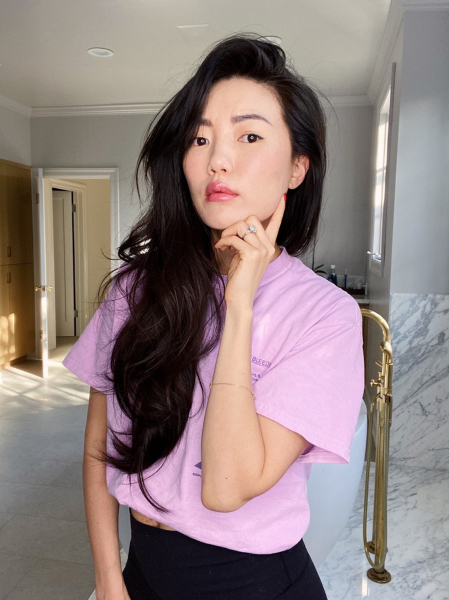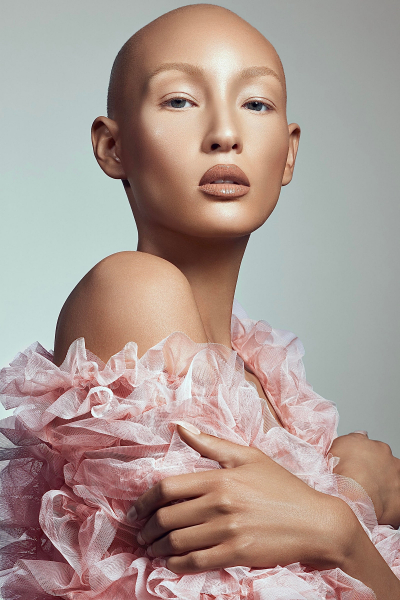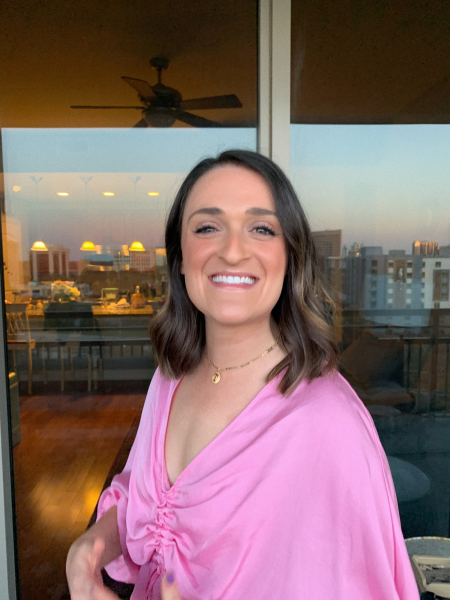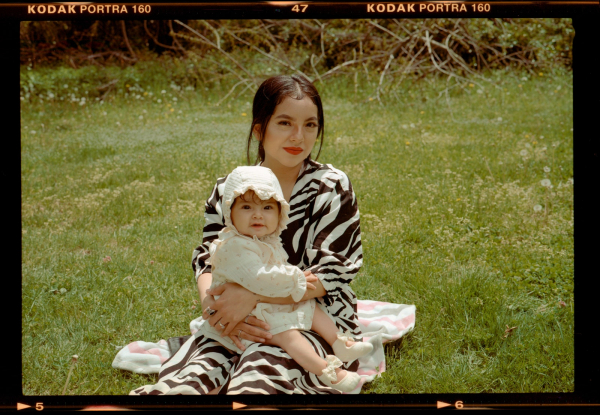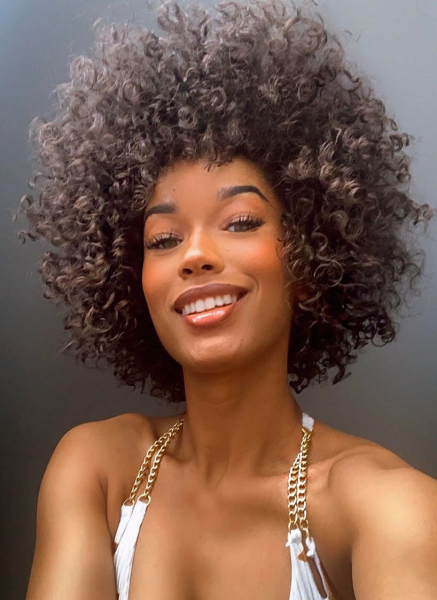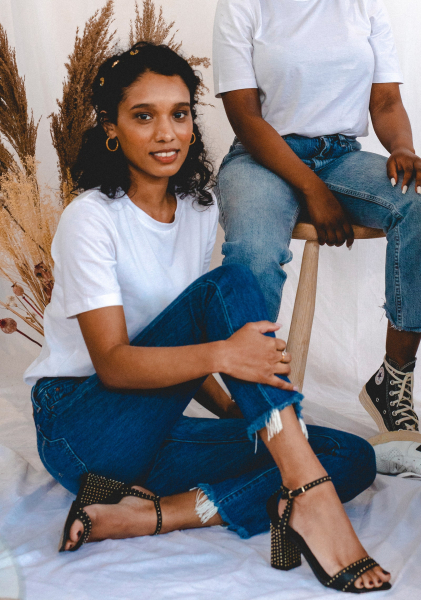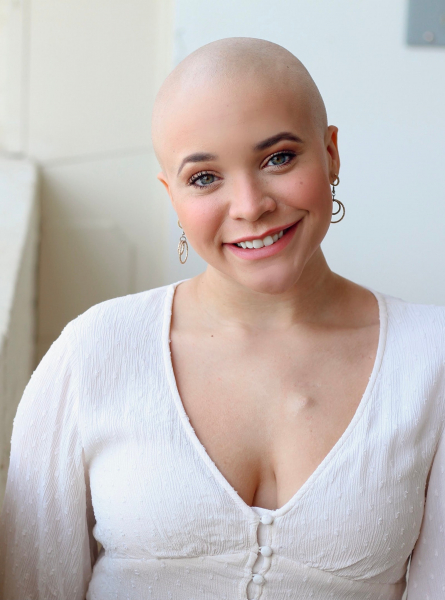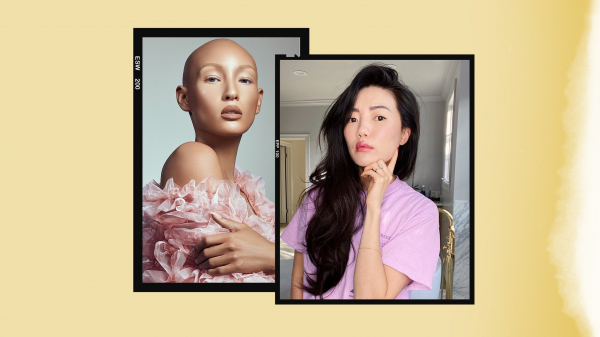 Courtesy subjects
Courtesy subjects
This story is a part of The Truth About Hair Loss, an exploration into why we lose our hair, the emotional and monetary costs that come along with the experience, and what the future of treatment (and acceptance) could look like.
"Why do I have to deal with hair loss? I'm not a middle-aged man," my 27-year-old sister Taylor recently asked me. Despite the fact that more than 50 percent of women experience noticeable hair loss in their lives, according to Cleveland Clinic, conversations about thinning hair are traditionally centered on men. Sometimes, just pointing out that some dude you just met at a bar or on a dating app is balding is a punchline. As an aspiring comedian, Taylor knows exactly what kinds of laughs that joke elicits. However, every time she's heard someone else say it, she wonders if they say the same about her when she walks away.
Arguably since the beginning of time, the ultimate stereotypical symbol of femininity has been long, flowing hair. Just look at Eve. Historically, she's been portrayed with waves down to her waist, either blowing behind her or falling across her chest like some sort of protection. Her hair is often what sets her apart from Adam. "Hair is something so intertwined with being a woman that when [they] start to lose their hair, it can take a huge toll," says Georgia Gaveras, a board-certified New York City-based psychiatrist and co-founder of Talkiatry. "For a lot of women, [their hair] is how they define themselves."
For the first time since it started thinning, my sister recently shared the details of her volatile relationship with her hair with me when we started talking for this piece. Over the years, I've seen how traumatic hair loss has been for her, but she's never talked about it directly. "It's a shame thing," Taylor admitted to me during our interview. "I never wanted to talk about it with anybody because I was embarrassed. The word balding is embarrassing. That's not even what this is. My hair is thinning, but in my head, when I see pictures, I feel bald. It makes me want to throw up."
Finally hearing Taylor's story motivated me to share it along with the experiences of several other women who lost their hair in their 20s — or even before. They are just a small selection of the 12 percent of women who experience hair loss before the age of 29, as studies have found. (By 49 years old, 25 percent of women do, too. That number increases to 41 by the age of 69.) Many of the women I talked to have been some of the loudest about sharing their stories on social media in hopes of destroying the stigma that hair loss is something only men deal with.
If you, too, deal with hair loss, Gaveras swears it's okay if it bothers you and makes you as physically ill as it makes my sister. "No one should be judged on that — just like no one should judge you if you decide to shave your head or grow your hair down to your toes," she says.
Amy Chang, 34
Beauty content creator based in Los Angeles
Courtesy of subject
Since third grade, Amy Chang's full, onyx hair had always fallen past her shoulder. Keeping it constant made her hair an afterthought. She took it for granted. Every other month, she'd dye it a deeper shade of black. Almost every day, she'd blow it out and reached for whatever hair products were lying around. Occasionally, Chang would even skip conditioner. "Looking back, I'm surprised it didn't fall out sooner," she says.
Skin, instead, was Chang's focus. Her complexion was everything. She directed her energy toward keeping it clear and acne-free. But when her hair started falling out, Chang had to redirect her attention toward it and redefine her relationship not only with her hair but also with herself. "I don't think I realized until that happened, how closely I tied my idea of my femininity, my identity, and my self-esteem [with] my hair," she admits.
While putting together before-and-after photos for a product she'd been testing, Chang's eyes were drawn to her hair for once. "My hairline had receded so much," she recalls. Fear, regret, and desperation took over.
"Thinking back, there were little signs along the way," Chang says. "First, my scalp started getting excessively oily, and it never was before. I would wash my hair, and then the next day, I would need to wash it again because it was so oily up top."
After visiting the doctor and having her blood tests come back clear of any allergies or vitamin deficiencies, she later self-diagnosed herself with a dehydrated scalp. With itchiness and flakes following her shedding, Chang learned these were symptoms of scalp inflammation, which blocked her follicles. (You can learn more about scalp inflammation by listening to episode 10 of Allure's The Science of Beauty podcast.)
Back in 2015, conversations on social media about women's hair loss were few and far between. Chang felt powerless. Desperate for more stories, she decided to share her own on a beauty blog she'd just started. She started interviewing hair loss experts for it, and through their knowledge, Chang felt like she was gaining her power back. "When I started to take those bits of information and really incorporate them into what I was doing for my hair care, and I started to see improvements, that fueled this whole excitement for me," Chang recalls. "Okay, there's something I can do about it."
As she found agency in the situation, the way Chang takes care of her hair completely shifted. Although she believes her hair looks better when it's blown out and colored, she doesn't do either anymore. The health of her hair, just like her skin, is her ultimate beauty priority. "The way I view my scalp now as an extension of my face," Chang says. "When I think about what I do to my hair, it's like, 'Would I do that to my face?'"
With all this in mind, Chang hopes conversations about women's hair loss become as normalized as that of acne has in recent years, so more resources become available. "For the longest time, nobody ever really talked about or showed real photos of themselves going through acne, severe acne, and talking about what worked," Chang explains. "Now, we have these great movements, like skin positivity, that have allowed all these conversations to happen and all of these great products and recommendations." In the process, acne has become a less scary situation for younger people — and people, in general.
In having these types of conversations about hair loss, Chang was able to come to the conclusion that she is more than her hair, "just as after I dealt with acne, I realized I'm more than just my skin," she says. Gaveras echoes her sentiment, adding, "What you have on your head doesn’t matter. You're still beautiful.”
Jeana Turner, 28
Model and wig designer and CEO of Los Angeles' Haus of Anomalí
Courtesy subject
Jeana Turner calls herself an alopecian, a word adopted by those with forms of alopecia. It's also an unofficial identifier that's made its way onto her impressive resume — but whatever you do, don't tack it onto the other titles on it. She is not simply an alopecian model.
If you watched cycle 24 of America's Next Top Model, you may have mistakenly thought of her as such. On the show, Turner grappled with embracing her baldness — and being an alopecian — for the first time. When she was about to turn 9, her hair started to fall out, leaving her totally bald by age 12 and constantly in tears.
At 8, Turner underwent a scalp biopsy, which determined an official diagnosis: alopecia, which is a chronic condition in which the immune system attacks the hair follicle. Originally, her dermatologist told her it was specifically alopecia areata, which mainly causes sudden patchiness. However, she's since experienced all stages of alopecia hair loss.
Before alopecia affected the state of her hair, Turner considered herself the girliest of girly girls. "I was blessed with the most beautiful 4C reddish-blonde hair," she recalls. "On a regular basis, I got relaxers, protective styling, and my edges laid. My hair was my everything, and my mom took care of it like it her own."
When her hair became nonexistent, Turner's mom continued to take on this supporting role. She even offered to shave her head to match for a matching bald look. "As wonderful as that would have been, this was my journey, so I never allowed her to do it," Turner says.
Turner's hair-loss experience wasn't always this positive, though. Not even a teen at the time of her diagnosis, Turner was convinced the world was over. Her self-esteem took a major blow as kids at school had brutal reactions to her baldness and wigs. Thankfully, the older she got, the less bullying she experienced. Through the process, Turner also realized mean people will always cross paths with her, and she "grew to accept [her] own fate — with or without hair."
Taylor Abelman, 27Courtesy of Subject
When my sister's hair started thinning when she was 22, she compares the jealousy and sadness she felt to people wanting to have a baby suddenly seeing babies everywhere, or those who want to be in a relationship walking outside and only passing couples. “If you want to have thick hair, you only see people with thick hair,” Taylor remarks.
While studying abroad in Italy her junior year of college, Taylor noticed more hair falling down the shower drain than usual. Her hair was longer and more knotty than usual, so she owed it to that. Back in America, Taylor noticed she was still losing lots of hair, though. Worried, she visited her college's health center to get her thyroid levels checked. All of her blood tests came back normal. The doctor wrote off her hair loss as stress. Wanting a second option, Taylor visited another physician, only to be told the same thing. "I didn’t really have any answers," she recalls. "I just assumed it would get better. Then, it did, but it goes in phases."
Over the past five years, Taylor's hair has cycled through thinning and getting full again over and over again — still without a clear diagnosis. Most recently, a doctor thought it may be telogen effluvium, a temporary form of hair loss that causes excessive shedding due to a shock to the system, as defined by Nazanin Saedi, an associate professor of dermatology at Thomas Jefferson University in Philadelphia for Allure. Many women have gotten this sort of diagnosis due to the pandemic. It's also often caused by hormonal swings. Shedding typically lasts three to six months, and regrowth can take up to a year, Amelia Hausauer, a board-certified dermatologist in Campbell, California, has previously shared.
Every time her hair starts falling out again, Taylor wonders if she's going to lose all of it. "There's anxiety thinking if this is the worst it's going to be or if this is the best it's going to be," she remarks. Neither option is great, she adds.
Growing up, our family moved around constantly. Every time we started at a new school in a new state, I coped by slipping on the brightest outfits I could find to counteract the dark thoughts that clouded my brain due to having to start all over again. Taylor always preferred to fit in. "I don't stand out unless I want to," she says.
If Taylor did lose all of her hair, she's sure she would constantly draw attention to herself, though, in ways she's long avoided. For the same reason, she says she never brings up her hair loss stress with friends because she doesn't want them to notice the state of her hair every time she sees them. "I always have a fear of my hair loss being noticeable, of people seeing it," she adds.
These days, Taylor finds comfort in knowing she's doing everything she possibly can to take care of her body from head to toe. Every hair is more precious to her now than ever, she says. She even takes Nutrafol, a daily hair wellness vitamin she heard about on a podcast. Knowing it's being advertised on her favorite shows made her realize she couldn't be the only one dealing with hair loss.
Over time, Taylor has also learned people don't notice her hair loss as much as she does. "It's the same way about pimples," she adds. In the early days, my sister was convinced everyone knew her hair was thinning but just kept comments to themselves. Now, she chooses to not imagine what others could possibly be thinking about her hair and look inward for confidence because, as she says, "I'm never going to know what people are thinking of me in general."
Monica Rivera Chillogallo, 28
New mother living in New York City
Courtesy subject
On September 20, 2020, Monica Rivera Chillogallo welcomed her baby daughter, Selena, to the world — and with Selena came postpartum hair loss. About four months after giving birth, Rivera Chillogallo absentmindedly ran her fingers through her hair, only to notice a wad of it in the palm of her hand. Panic immediately set in.
Prior to getting pregnant, Rivera Chillogallo says her hair was always dependable. Through all her experimentation, it seemed to put up with everything. "Whether it was buzzing it all off or dyeing it bold colors — I've even bleached it three times in one day and completely fried it — I could always depend on my hair to grow back super quick and thick," she explains. Yet, now, her long, raven hair seemed to be failing her.
Knowing her cousin just had a baby, too, Rivera Chillogallo called her up to ask if she was also losing her hair. "[My cousin] right away said that isn't normal. You need to go to the doctor," Rivera Chillogallo recalls. “After that, I called my mom and my aunts on both sides of my family. They all told me the same thing: They've never experienced any hair loss after giving birth; I need to make a doctor's appointment as soon as possible, which caused me to panic even more.”
After undergoing several tests, Rivera Chillogallo's doctor later assured her that not only is she perfectly healthy, but also her hair should be back to normal by the time her daughter is one. In fact, postpartum hair loss is extremely common, affecting between 40 and 50 percent of women, according to the American Pregnancy Association.
In the meantime, Rivera Chillogallo's mom started whipping up homemade nourishing scalp masks right away and putting her daughter on a set hair-care routine, all the way down to washing her hair for her. "Natural remedies are a thing for my family," Rivera Chillogallo adds. "Everything’s been passed down from my grandmas to my mom."
Her husband, on the other hand, shared words of reassurance and compliments, especially when she dreaded leaving the house. "I felt so ugly," Rivera Chillogallo says. "I couldn't have my hair down because it would just fall right out, and you'd see hair all over the place. He would tell me how beautiful I am with or without hair," she continues. "I know it sounds silly, but it did help me on some days."
After her "devastating" hair loss experience, Rivera Chillogallo admits she now has an intense bond with her hair. Rivera Chillogallo continues masking alongside scrupulously reading the ingredients in her hair products. As she approaches Selena's first birthday, Rivera Chillogallo has this message for other new parents experiencing postpartum hair loss. "It gets better," she says. "Our bodies went through so much bringing life into it, and this is one more thing our bodies go through."
Christina Porter, 27
Model based in Houston
Courtesy subject
Christina Porter had suspicions she was losing her hair back in 2019. Unlike Rivera Chillogallo, chunks of her curls weren't falling out, but Porter could just tell. As a model, she's constantly staring at photos of herself. The difference in the thickness and definition seemed obvious, even if Porter didn't have tangible evidence.
Soon, a continuously clogged sink confirmed Porter wasn't just imagining things. A maintenance man came by her home and pulled a ball of hair out of it, only to come back two months later to retrieve yet another.
At first, Porter couldn't figure out the culprit for her breakage, thinning hair, and bald patches. For years, her coiled hair was luscious and thick thanks, she thinks, to daily vitamins and a consistent hair-care routine based around her favorite curl-defining product. She also kept up with monthly trims with the help of her hairstylist mother.
"I wanted to assume it was stress, but I wasn't going through anything major for me to be stressed out about," Porter says. "The only thing I could think of was the hair product, and sure enough when I went onto its Instagram, thousands of women were complaining and going through the same thing I was experiencing — if not worse."
To help her deal with the damage, Porter's mother wanted to give her a big chop. However, Porter chose to transition without a cut so she could keep as much of her hair as possible due to the reality of her job. "I needed some hair on my head or else I wouldn't get booked," she says. Porter's mom, instead, helped her change up her hair-care regimen.
Two years later, Porter is still recovering. She often shares updates on her hair loss on her progress on TikTok now, including her latest product lineup and the results of the in-salon deep-conditioning treatments she's been getting to help her curl pattern bounce back. Most of all, Porter reminds others dealing with product-related hair loss to be patient and avoid comparison. "Take this time to get to know your hair and appreciate what you have now," she says. "It's a long process, but you'll get there."
Keerthana Kethies, 28
Accountant and content creator in London
Courtesy subject
Keerthana Kethies never really loved her hair. She thought of it as too thick, too curly, too frizzy, and too unruly for her. For years, she fought against her natural texture, resorting to straightening it constantly. Although her family warned her all the heat damage would take a toll on her hair, Kethies says she never took their concerns seriously.
Slowly but surely over the past 10 years, Kethies' hair got thinner and thinner. Eventually, she realized her hair density was only a fraction of what it once was, so something had to be amiss. However, every time she got blood tests done, doctors told Kethies that she was perfectly healthy, barring low iron and vitamin D levels. They'd assure her losing some hair was completely normal, and she accepted their explanations.
At the end of 2019, the hair on the top of her head was thinner than ever, and Kethies noticed she was shedding more than usual. "I rapidly went from being rather nonchalant about losing my hair with an air of 'it will fix itself' to frustration, anger, and helplessness," she recalls. "I began to miss the different ways I enjoyed styling my hair and felt uncomfortable in anything but a low bun."
Needing more answers to her hair loss woes, Kethies booked an appointment with a trichologist earlier this year. At their hair loss clinic, Kethies was finally diagnosed with androgenetic alopecia aka female pattern baldness, a hereditary condition that accounts for the most common cause of hair loss. It tends to happen slowly and gradually with a widening center part, New York City-based board-certified dermatologist Michelle Henry has previously told Allure. Unlike telogen effluvium, it's not influenced by stress, Hartman has also mentioned.
Naturally, this discovery was upsetting for Kethies. However, she felt relief knowing what she's fighting against. Now, feeding her hair with all the nutrients it needs to thrive and increase blood flow to her scalp is Kethies' goal, she shares. Daily scalp massages have also been worked into her daily routine. Once a week, she even does so with a derma roller and rosemary oil, which studies have found can be as effective for promoting hair growth as minoxidil (the active ingredient in Rogaine). Kethies hopes more hair loss products will become available for women as more share their stories. "If you Google hair loss, you are shown products for men first before women," she explains. "Even the products for women are pretty questionable and confusing."
"If you Google hair loss, you are shown products for men first before women. Even the products for women are pretty questionable and confusing."
Prior to her diagnosis, Kethies minimized the number of selfies she posted on Instagram because she hated the way she looked. Scrolling through her feed just perpetuated her insecurities surrounding her hair. "Social media has perpetuated this culture of perfection, vanity, and unattainable beauty standards that it’s almost impossible not to feel some form of insecurity in areas where you think you are lacking," Kethies shares.
These days, Kethies is still learning how to detach her diagnosis from her identity, that it's not her only crowning glory. To combat the negativity she feels from social media, Kethies has started sharing her experiences with female pattern baldness on TikTok and Instagram. In the process, she's built stronger confidence in herself and is overcoming her insecurities, especially knowing her story is resonating with other women struggling with hair loss. "Discovering a supportive community and realizing that I am not the only one going through this has been the most significant comfort," she says. "To anyone who is suffering, know that you are not alone. A small but supportive community is out there willing to help and be there with you on your journey."
Savannah Cooper, 20
Dancer, actor, and college student in Lexington, Kentucky
Courtesy subject
Growing up, Savannah Cooper loved when her mom did her hair every morning before school. Her tightly curled hair was a fun canvas for different hairstyles, and Cooper looked forward to whatever her mom had in mind for it next. By seventh grade, though, Cooper's mom wouldn't have any hair on her daughter's head to work with.
At seven years old, Cooper was diagnosed with Ehlers-Danlos Syndrome and Tethered Cord Syndrome after experiencing chronic pain in her back. After getting surgery on her spine, she started taking countless medications to manage her pain and illnesses. A side effect of them struck when she was about 10 years old. Small bald patches started cropping up all over her head. "I was very upset and embarrassed by my hair loss," she recalls. "I also remember feeling very confused."
However, Cooper had yet to reach the hardest part of her hair loss journey. Her hair grew back for a few years, but when she was in seventh grade it started falling out again — this time, rapidly. She was in middle school, extremely ashamed and terrified her classmates would notice what she was going through. At home, Cooper was heartbroken as she noticed her bald spots multiply and grow bigger and bigger. "Eventually, I had to face the fact that I was losing all of my hair," she shares, noting that she's been bald ever since.
Struggling with the thought of looking "different" from her classmates, Cooper hid her baldness away under wigs that looked as natural as possible. Every day, she slipped one on as she accepted her hair wasn't coming back any time soon. "Wigs provided a huge relief for my overall anxiety," Cooper says. However, she now realizes she was focusing so much attention on concealing what was happening instead of embracing her true self. "It became exhausting," she adds.
Her body was physically exhausted, too. In middle school, Cooper also started suffering the first of dozens of kidney infections she's had to this day. "My physicians have said my hair loss is caused by the stress on my body from being chronically ill, as well as the many medications I have to take," she says.
Solace throughout these hardships came in the form of connecting with other young people struggling with hair loss, Cooper says. As she started feeling less alone and less inclined to fit into conventional beauty standards, she stopped wearing her wigs around family and close friends. A few days before starting junior year of high school, Cooper was ready to set it aside altogether. "I finally felt confident and beautiful in my own skin," she says, "and decided it was time to embrace my hair loss."
In 2017, Cooper founded SavStrong, a non-profit organization that raises awareness and funds for chronically ill patients and families. Through panels, social media, and fundraisers, she helps kids dealing with hair loss learn that struggling with hair loss doesn't make them any less beautiful. Instead, they are challenging society's definitions of beauty and setting new standards. "Knowing I am able to inspire and encourage younger people really puts all of this into perspective," Cooper says. "It gives me the motivation to continue embracing my hair loss."
If you're dealing with hair loss and intrusive thoughts surrounding it, Gaveras ultimately recommends changing your matter of thinking. Assuming you're healthy, ask yourself why your hair loss is bothering you so much. "What is my hair? What does it mean to me? What has it meant to me?" she continues. "That is a lot more useful discussion to have."
